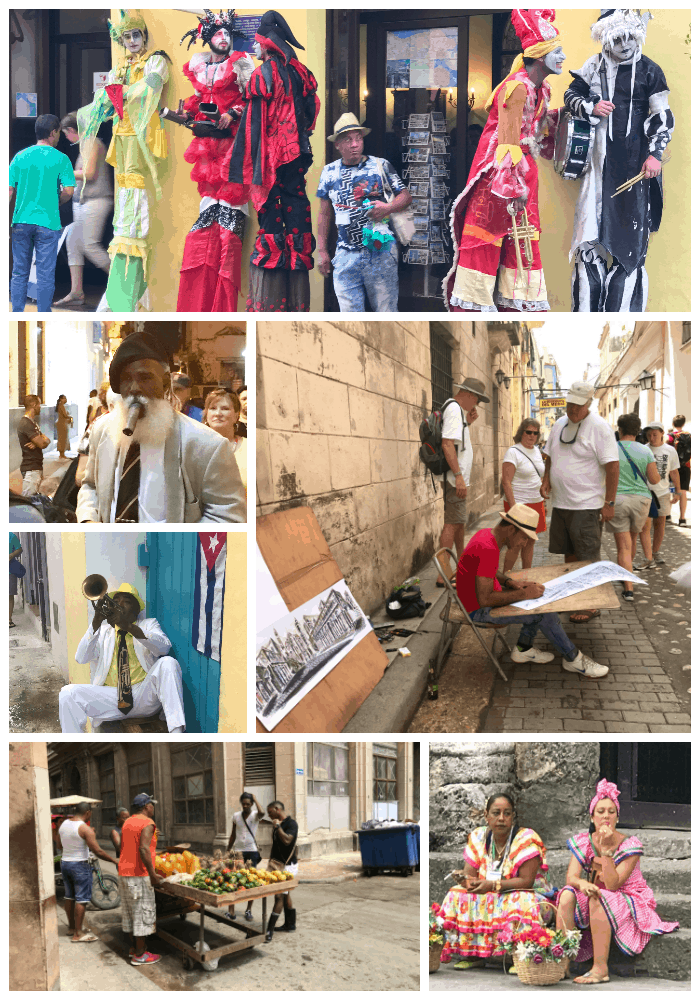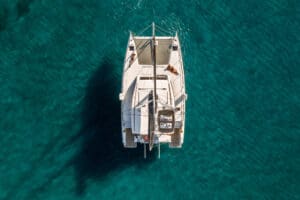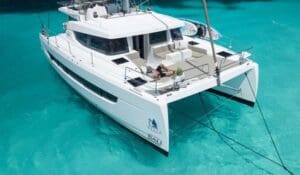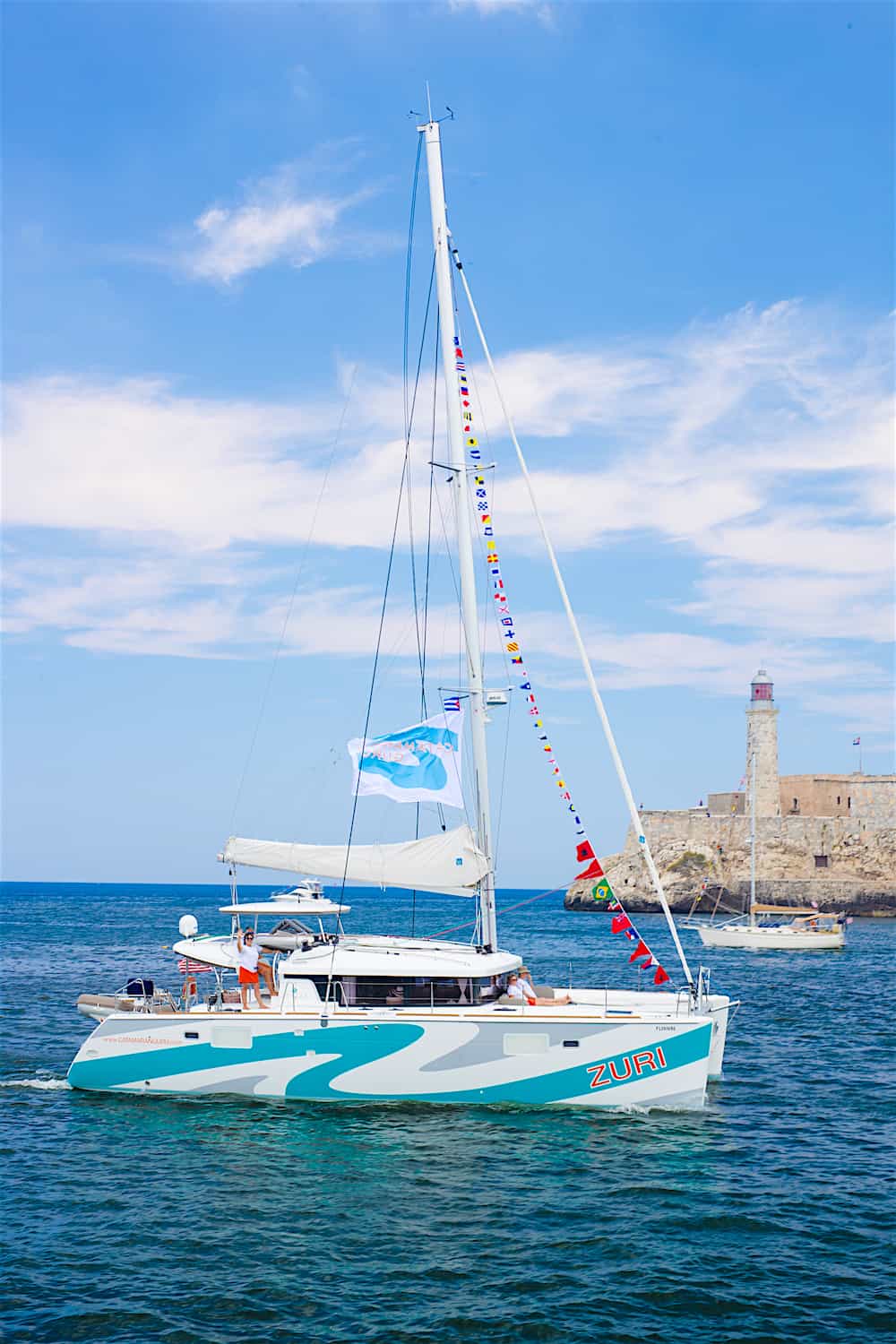
On March 30, 2017, we joined the Cruising World Expedition and Rally to Cuba. This adventure took us a distance of 98NM across the Florida Straits from Key West to Havana, Cuba. A fleet of sixty boats dotted the horizon with white sails as we set off that evening in a gentle breeze. The wind steadily increased during the night to 25 knots and the sea state responded with fierceness to the increased wind against the opposing Gulf Stream. It made for an ugly confused sea but Zuri took it in her stride and responded like the sailing machine that she is.
We had one reef in the mainsail and Zuri’s leeward hull dug into the raging sea but she never lost any speed. We were sailing in the double digits, up to 14 knots at some points during the night. Even though our boat speed was in the double digits, our speed over ground (SOG) was greatly diminished due to the relentless Gulf Stream pushing against us as we smashed into the waves.
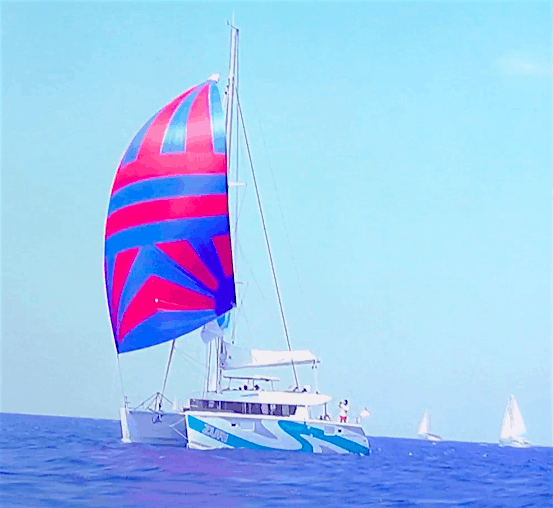
At sunrise we could see the skyline of the city of Havana and we were greatly relieved. It was an uncomfortable ride and we noticed that many of the other boats did not fare quite as well as we did. As we approached the entrance to the marina, we realized that we were one of the first sailboats waiting to enter the marina, even though we left at the back of the pack. Our sail from Key West to Havana took us a total of 15 hours. Once again Zuri showed her prowess at sea! By the way, both Waterway Guide Cuba and Cuba: A Cruising Guide are great resources.
Customs and Immigration in Cuba
Once you are cleared to travel to Cuba by the U.S. government with a U.S. Coast Guard permit to enter Cuban Territorial waters as well as travel affidavits for the crew, you are good to go and it’s a fairly easy process. (To learn more about the legality of traveling to Cuba as an American, check out the Treasury Department’s Cuba FAQ). However, when it comes to doing “formalities” at customs and immigration in Cuba, patience is a virtue! We were lucky to be part of the Cruising World Rally because everything was expedited for us. They had to process sixty boats during the course of the day, not an easy feat at any level, so they made sure that officials were ready to deal with us quickly. In ordinary circumstances, it could take several hours if not all day for one boat to clear into the country.
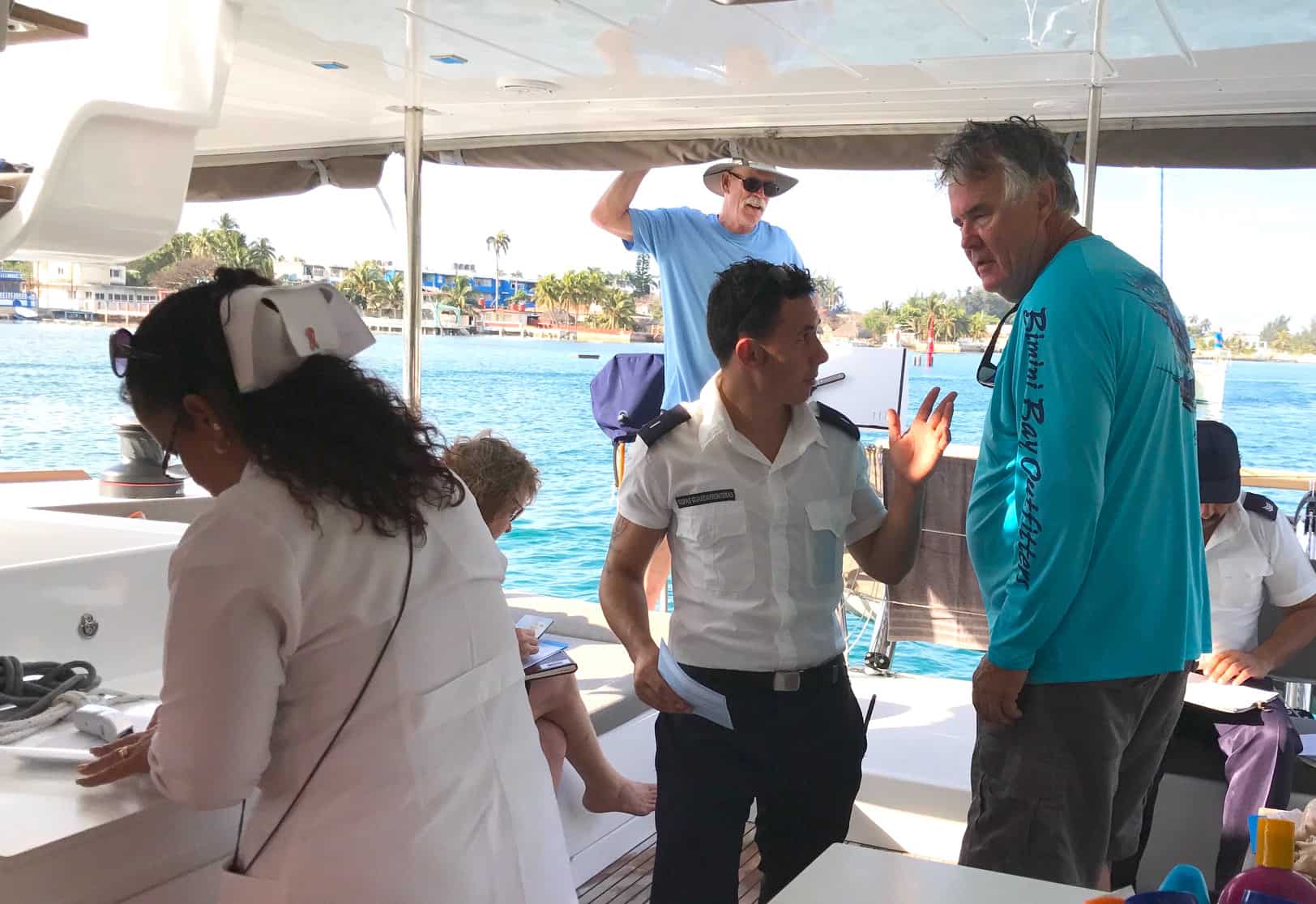
Very polite and professional customs officials met us at the Customs Dock. They approached the boat, dressed in impeccable uniforms, and asked permission to board, each removing their shoes as they boarded. Many spoke a bit of English. First the customs officer made sure our papers were in order. Then the nurse came aboard and astonishingly, took our temperatures (bird flu anyone?). Next, a doctor asked us about our health and gave us tips about health hazards, dehydration and other ailments. The agriculture official inspected the boat for meat, fruit, vegetables and checked labels on food for expiry dates.
Finally we were asked to exit the boat and go to the immigration office on the dock where they matched passports to each crewmember. When completed, Zuri was escorted to her assigned dock. Marina Hemingway with its canal style docks has an air of forlornness, but it is patrolled 24/7 and fitted with lighthouses, power and water. We did experience outages while we were there but all in all it was not too bad. It has an official capacity of 400 boats but in reality, there are only about 100 usable slips.
With “formalities” squared away, we explored the property and pretty soon our curiosity led us the Hemingway International Yacht Club (of which we are now members). This is where we tasted our first Mojitos in Cuba, freshly made by our bartender! Needless to say, we spent a few hours there and made fast friends. One of them was Phil Thompson, an American expat, intrepid fisherman and author. He immediately welcomed us and started educating us about Cuba and its people. He is the author of several works including “97 Miles South – Key West to Cuba” which he promptly signed for us after the bar tender sold us the book. Those Mojitos have a fierce kick and after a sleepless night, we retired early but excited for the adventure to continue.
Noonsite’s information about Cuba Formalities for Customs, Immigration, Fees, Documents, Restrictions, Pets, Firearms etc. is very helpful.
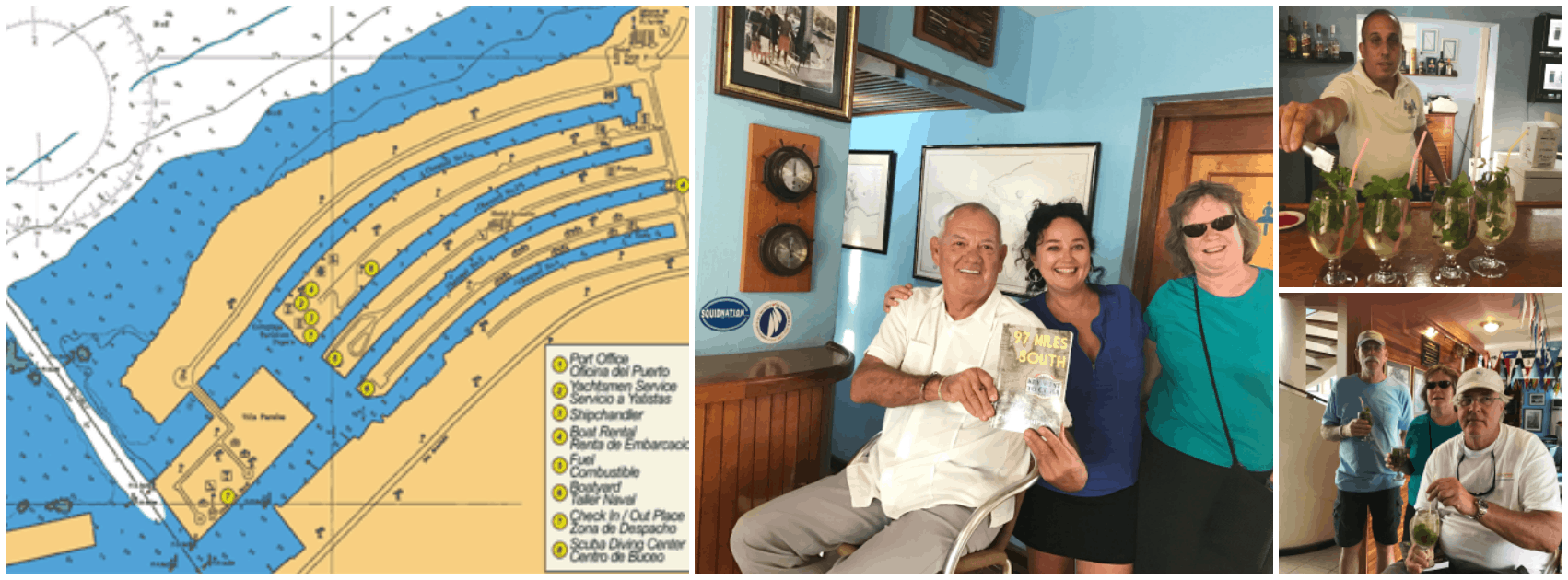
Historic “Parade Of Boats” Into Havana Harbor, Cuba 2017
On April 1st we took part in the parade of boats through Havana Harbor, something that is usually forbidden for pleasure boats. Commodore Escrich of Hemingway International Yacht Club organized this historic event to show a hand of friendship and cooperation between the sailors of Cuba and America. (Check out this exciting sailing video below).
We all set off from Hemingway Marina, checked out at the customs dock and meandered one behind the other, to the harbor, about seven miles away. We slowly made our way to the Havana Harbor past the historic Malecon and the El Morrow Castle where the Cuban crowds cheered us on. Chants of, “Viva America!” and “Zuri, Zuri!”, rang out from the waving spectators. It was a site to behold! At that moment we all felt pride in our countries and in the sport of sailing.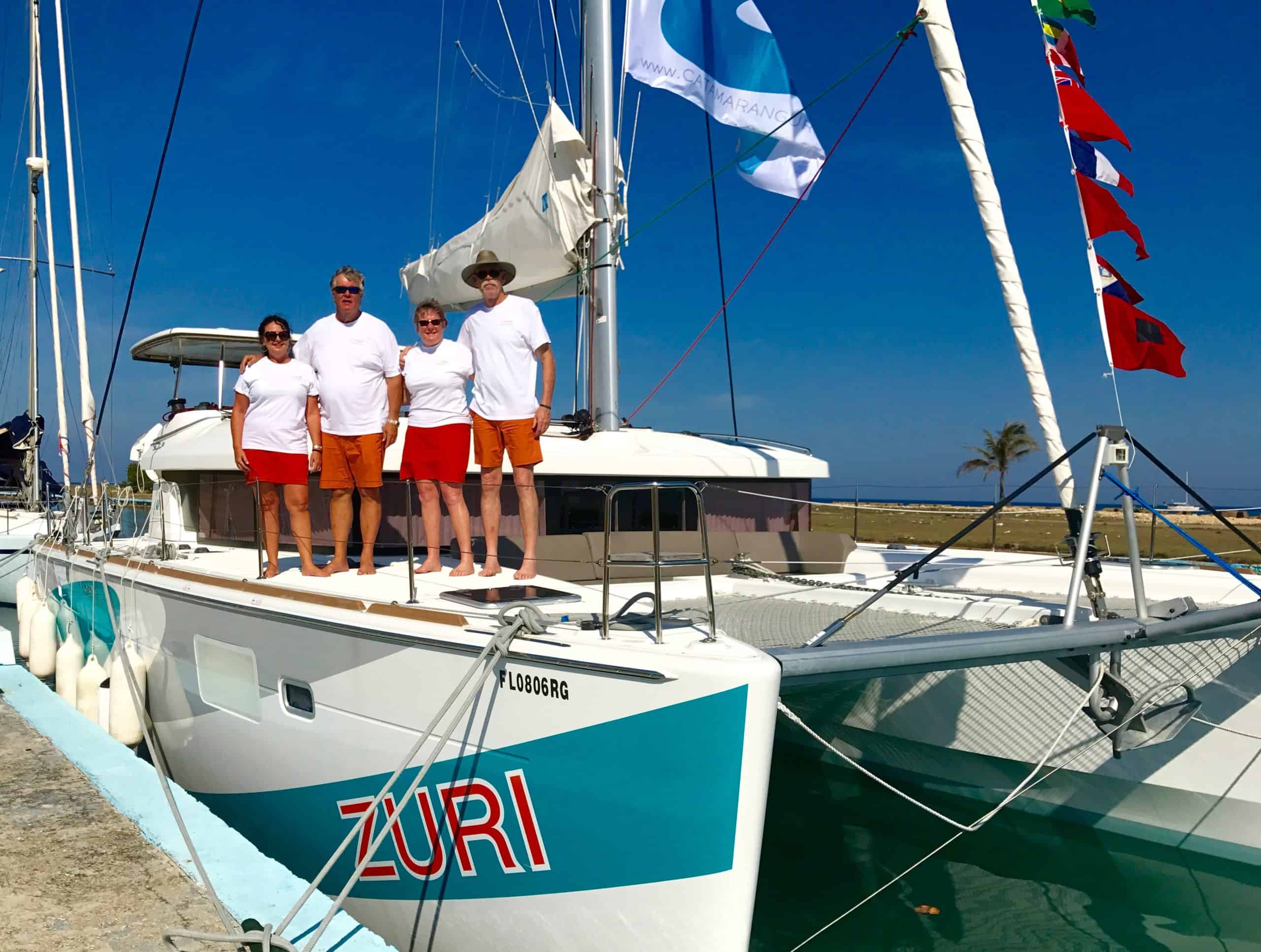
After exciting the harbor and saluting the Hemingway Yacht Club Commodore, we all sailed the eight miles back to marina Hemingway. With our giant blue and red spinnaker set, and the Catamaran Guru battle flag flying high, we were off to the races. This wasn’t officially a race, but every sailor knows that if there is more than one sailboat on the water, there’s a race. Zuri once again galloped past the entire field on a perfect spinnaker run back to our slip in Hemingway Marina. We were the first boat on the customs dock to check back into the marina. We had passed all 41 boats in front of us.
Commodore Escrich rewarded Zuri and her crew with a great bottle of Havana Club Rum that night at the prize giving for our “Great Impression” at the parade! Our able crewmember, Donald, quipped: ”I don’t speak Spanish, but that must mean we kicked ass, right?” Just a little gloating from our crew there! Zuri was also a hit on Cuban National Television news that evening. We did not understand the commentary since it was in Spanish but the commentator excitedly chatted away while Zuri dominated the footage with her blue and red spinnaker and teal and gray graphics on the hull. We can still hear the chants, “Zuri, Zuri!”. We were pleased as punch. To celebrate, we proceeded to drink copious amounts of Mojitos and we danced the night away with some awesome Cuban musicians.
Exploring Havana, Cuba
The next day we did an “orientation” walking tour of Old Havana (Havana Vieja) with the group of sailors. We don’t do well with organized tours but this was a smart move to initially get our bearings so to speak and to take in some of the city’s most iconic sites. After all, it’s been twenty years since we sailed into Cuba. The island of Cuba conjures up images of Cohiba cigars, Castro, old classic pre-revolution American cars, mojitos and Hemingway. All of that is in evidence everywhere in Havana and best of all, there is an excitement in this bustling city that is palpable.
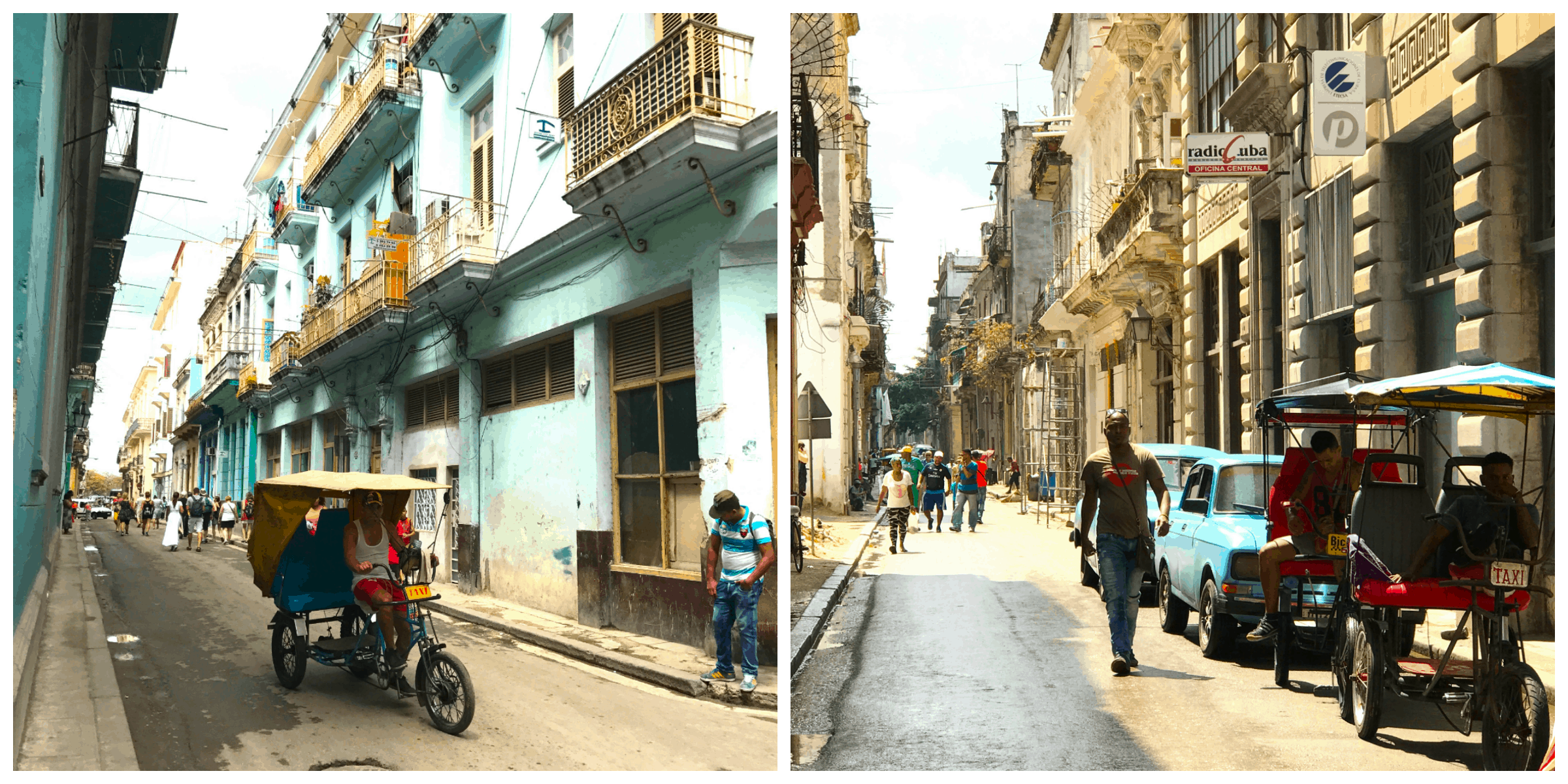
Some buildings are in bad shape and one can see vegetation grow out of the concrete. Looking down the narrow streets you can see the laundry hanging on lines out the windows and off of balconies.
Cuba’s legendary capital (now included in the UNESCO list of World Monuments) is a city of contrasts and contradictions. It is seemingly trapped in the 1950’s but it is visibly straining against the restrictions of progress. On the surface Cubans are content but privately they yearn for a better life. Cuba stands as one of the world’s last bastions of communism and even though the system is much relaxed, the people are still excluded from things that westerners take for granted, if not by the government, then definitely by economics. These guys earn buttons and therefor the Cubans, even though loyal to the leadership of the country in public, are ready for change.
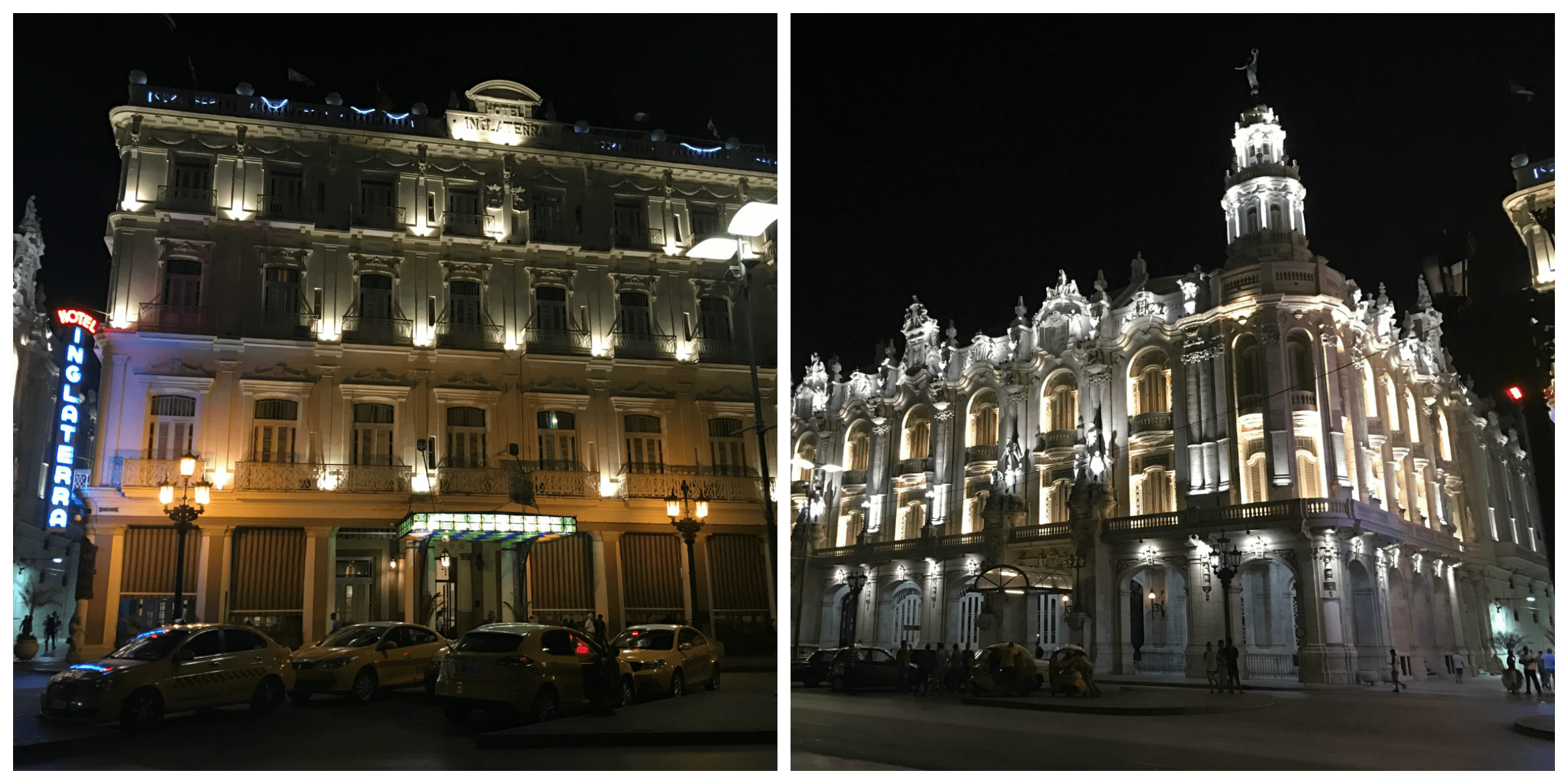
>>Central Park, Havana Cuba: Hotel Inglaterra & Gran Teatro De La Habana
The grandeur of yesteryear is still evident in the weathered opulent colonial buildings, beautiful but crumbling from years of neglect. Some of these buildings are now being restored but there is so much to fix, the task seems insurmountable. Despite all that, the people seem upbeat, are friendly and welcoming and beyond thrilled that American tourists are visiting.
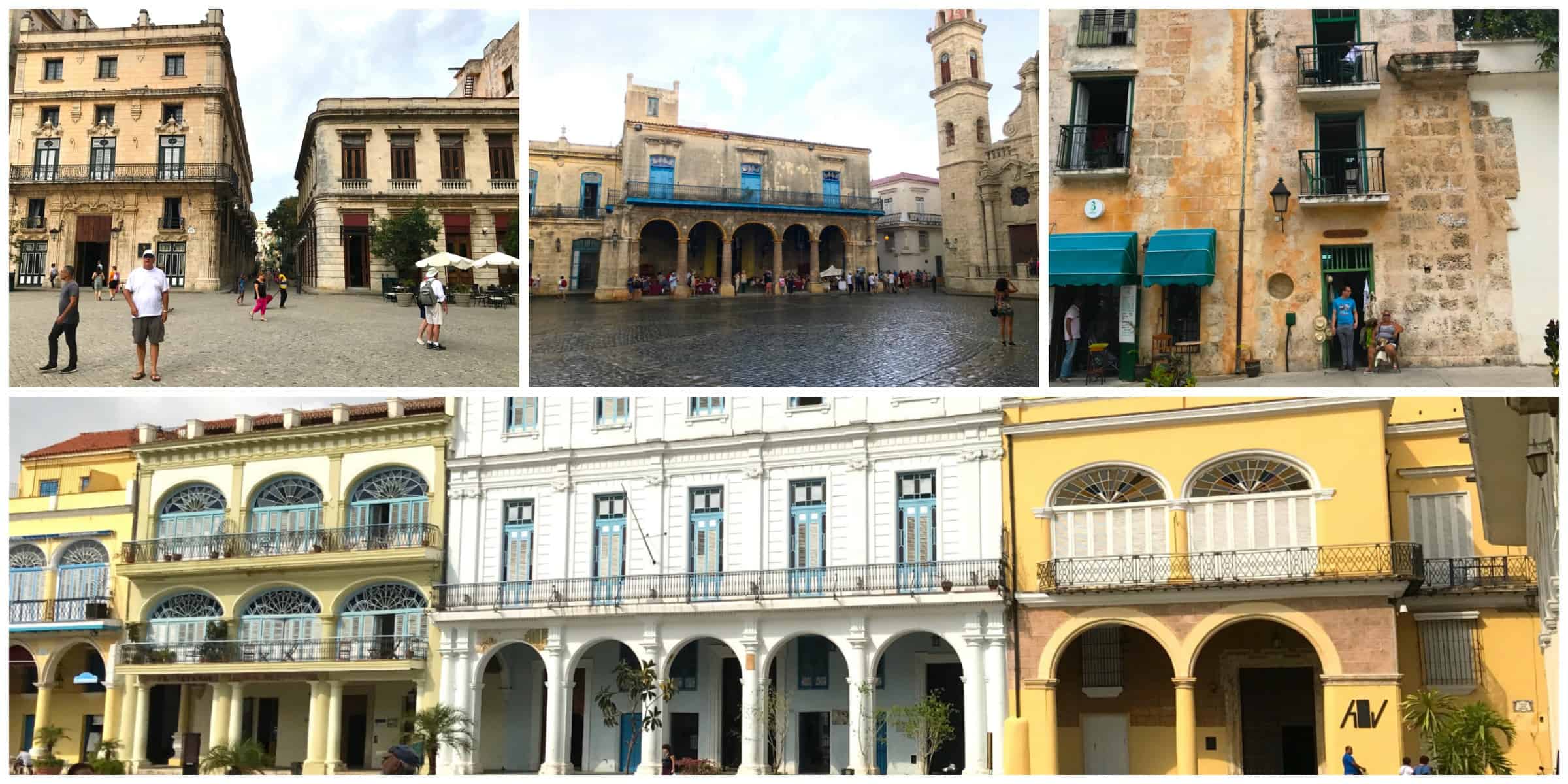
>>Several squares in Old Havana form the heart of activity in the city
We broke off from the pack around lunch time to see some of the sites we visited 20 years ago, like La Bodeguita del Medio, one of Hemingway’s favorite bars (yes, another one of his watering holes) and the Hotel Nacional, where we stayed during our trip here. They still have some of the best Mojitos anywhere!
Street Life In Cuba
The streets are lively! Every day a group of performers, walking on stilts, dressed in colorful costumes, take the streets of Old Havana by storm. On their daily route up Obispo Avenue, these colorful street performers liven up the city streets while they perform to the rhythm of the conga. What a treat to see these guys in action. These simple everyday happenings from the street explain it all. The progress and lack of progress, the broken down pre-Revolution American cars, serving as taxis, the entrepreneurs selling art in the street, the musicians and the dancers performing for a peso, the potent mojitos and finally the resilient Cuban people. Their spirit is infectious!
One of our crewmembers, Donald, a first time visitor to Havana describes it like this: “Since the revolution in the early 1960s and the institution of Communism, progress has come to a stand still. Other than erecting statues, signs, and monument of their Revolutionary heroes, the city has been left to erosion and neglect. A close watch must be kept when walking. One eye for the taxis, horse drawn carts, mopeds, trucks, and people, the other for the crumbling concrete, raised paving stones, pieces of re-rod, and open man hole covers make for a challenging stroll through the city. Add a few mojitos in the mix, and it’s a formula for disaster. Some buildings are in such disarray that vegetation and trees are growing out of the concrete from each floor. Looking down the narrow streets you can see the laundry hanging on lines out the windows and off of balconies.
Classic American cars are the dominant form of transportation in the city. The latest models I saw were 1961s, when ties with the United States were severed, and no more could be imported. In order to keep them running, the cars have been cannibalized with home made parts. Some have Japanese and Russian engines. Most are loaded with body filler, and painted with rollers using house paint. Some classic car colors are off the charts with bright yellow, pink, and purple. You may even see a four door convertible as they cut off the roofs, because taxi fares are higher for a convertible”.
Funny but true!
Paladares: Private Family Restaurants
During our stay we took advantage of the Cuban food scene in Havana and had great food during our time in Havana, in family owned restaurants or 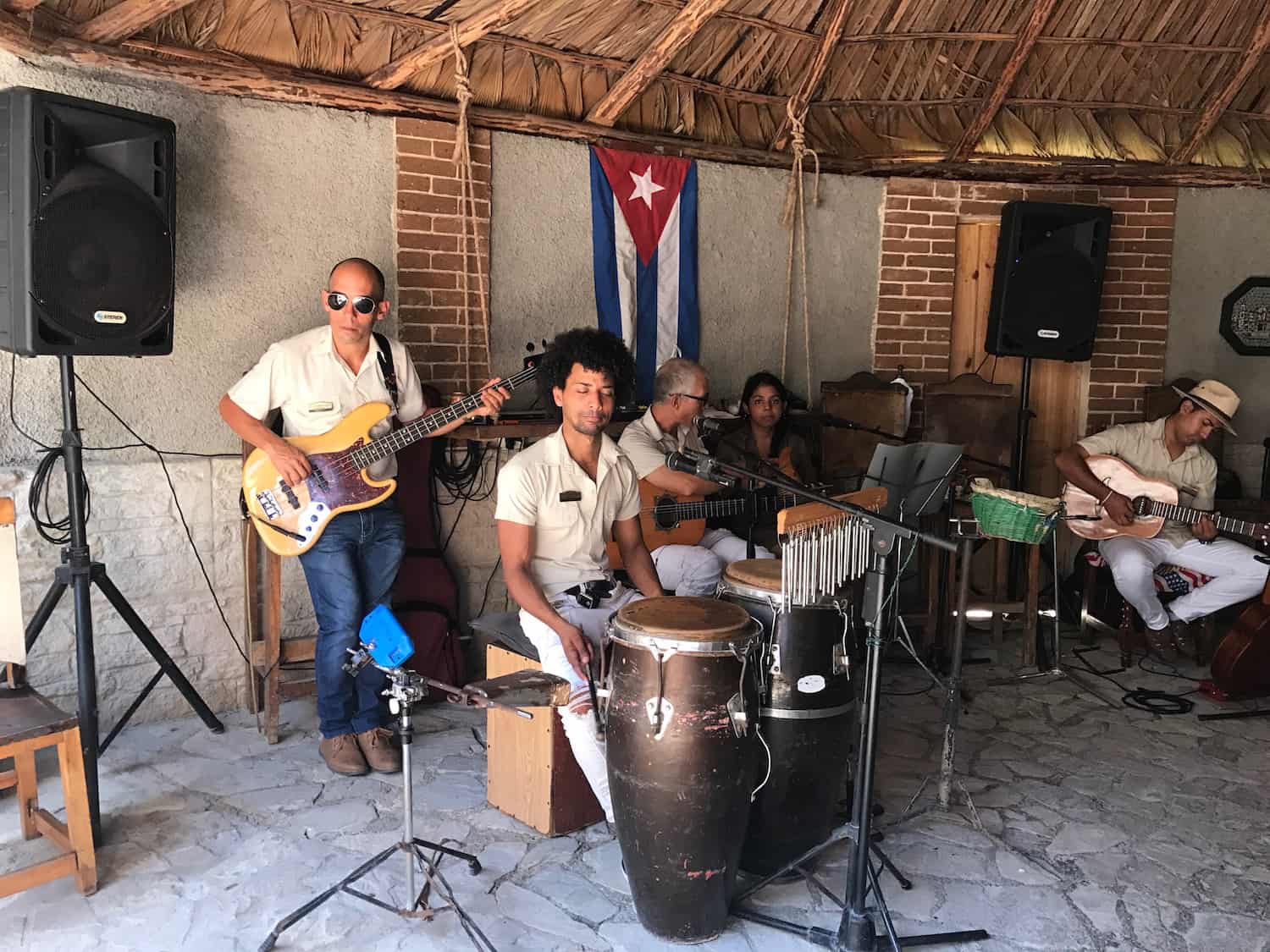 paladares, as they are locally known. We were pleasantly surprised, as the food 20 years ago was very basic and frankly, even the Hotel Nacional at the time ran out of most items on the menu, so it was pretty much a case of – “…take or leave it. This is what we have today”. In 2010 Raul Castro called for reforms as he downsized the number of state jobs and pushed more Cubans into the private sector. It was a matter of survival for the government and the “restaurant business” benefited hugely from this change. One of his favorite restaurants is El Cononazo.
paladares, as they are locally known. We were pleasantly surprised, as the food 20 years ago was very basic and frankly, even the Hotel Nacional at the time ran out of most items on the menu, so it was pretty much a case of – “…take or leave it. This is what we have today”. In 2010 Raul Castro called for reforms as he downsized the number of state jobs and pushed more Cubans into the private sector. It was a matter of survival for the government and the “restaurant business” benefited hugely from this change. One of his favorite restaurants is El Cononazo.
Just across the harbor from Old Havana, near La Punta Fort is an area known as La Cabaña, a small community – two streets with only 30 houses. One of these houses is known as Hostal El Cañonazo, a three-guestroom “casa particular” with a charming backyard paladar restaurant with great service, live band and beautifully prepared Cuban cuisine including huge lobsters at very reasonable prices. No wonder Raul enjoys the place!
Another time while strolling through the streets of Havana, we were attracted by some sultry Cuban music coming from the rooftop of one of these old dilapidated buildings. We followed the music and climbed very narrow stairs, three stories high to be met by the staff / family of the Familia paladar. After the scorching heat in the streets this was a cool breezy oasis with live musicians, friendly staff and a sumptuous meal of fresh fish, crispy tostones, sweet plantains and black beans and rice. If you take the time to explore off the beaten track, many such welcome surprises will be open to you. Other Paladares and Bars Worth A Try: El Laurel / Galleon / El Guarida / Cafe Laurent / Café Paris / La Bodegita el Medio / Dona Eutemia / Hotel Ambos Mundos / Hotel Nacional for mojitos
A Special Hand Rolled Cigar By Legendary Cueto
As we all know, hand-rolled Cuban cigars is prized all over the world and cigar culture is huge in Cuba. Every Cuban receives a box of cigars from the government every month and it is not uncommon to walk down any street in Havana and see locals puffing away as they go about their daily business. Castro favored the famous Cohibas while Che Guevara liked Montecristos but there are many varieties, all exceptional according to people in the know. It is said that Cuban cigars are so good because it has excellent conditions for growing tobacco as well as their years of growing experience.
One of the highlights of our exploration in Havana was our discovery of Guinness world record-setting Cuban cigar roller Jose Castelar at the El Morrow castle. We happened upon Cueto (as he is locally known) and what a treat! He is famous for his world records but also for being the preferred roller for Castro for whom he rolled a cigar that measures 90-metre (295-feet) to celebrate the 90th birthday of the revolutionary leader. He is a legend in Cuba and has magic hands according to the locals. This guy rolled cigars for people like Putin, Jack Nicholson, JayZ, and other bigwigs. So we were surprised when he offered to do a demonstration just for us. What a treat, specially since he handed us the cigar as a memento! Check out tobacco farming in Cuba here.
Our Impressions Of Cuba 20 Years After Our First Visit
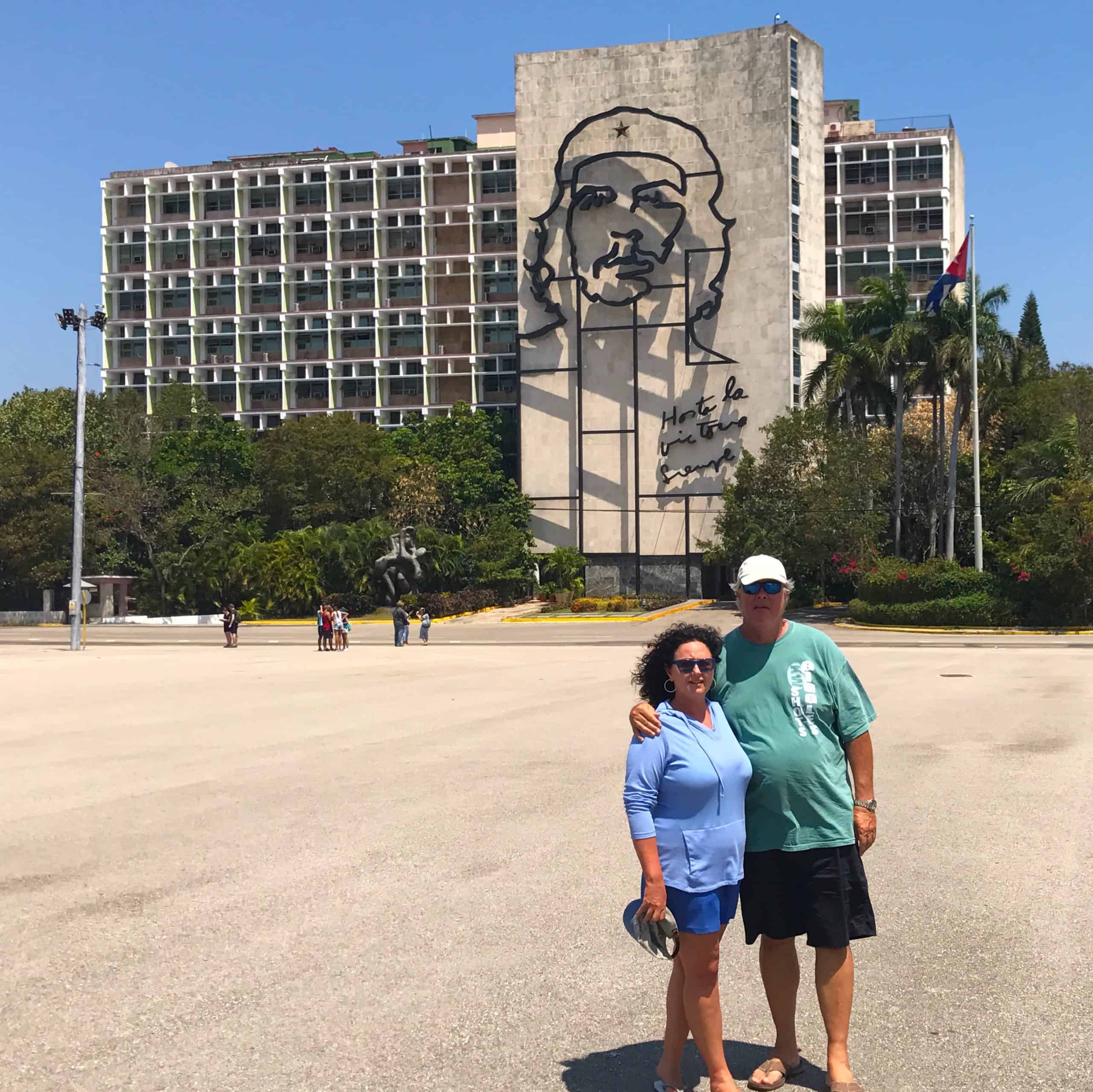 On April 8th we concluded the Cruising World Expedition and Rally to Cuba. As we departed Marina
On April 8th we concluded the Cruising World Expedition and Rally to Cuba. As we departed Marina
Hemingway for Fort Lauderdale, it was clear to us all that Cuba is a very special place and many cruisers are flocking to this hereto forbidden land. This was a whirlwind of a trip for us and we did not have time to REALLY explore.
We mostly did surface stuff, not our usual mode of travel. But we will be back and will stay long enough to properly get to know the people and the country. Based on our brief visit, the most obvious changes we saw from our visit 20 years ago are:
- Some of the buildings are now painted (there was NO freshly painted buildings then)
- Lack of tourist police, which 20 years ago was a constant presence everywhere.
- Private taxis (classic cars) are allowed and is a major tourist attraction
- Private family owned restaurants called “paladars” are allowed now with a limit on seating but it seems that this rule is not strictly enforced
- Private accommodations, called “casas particulares” are available everywhere at as little as $25/night
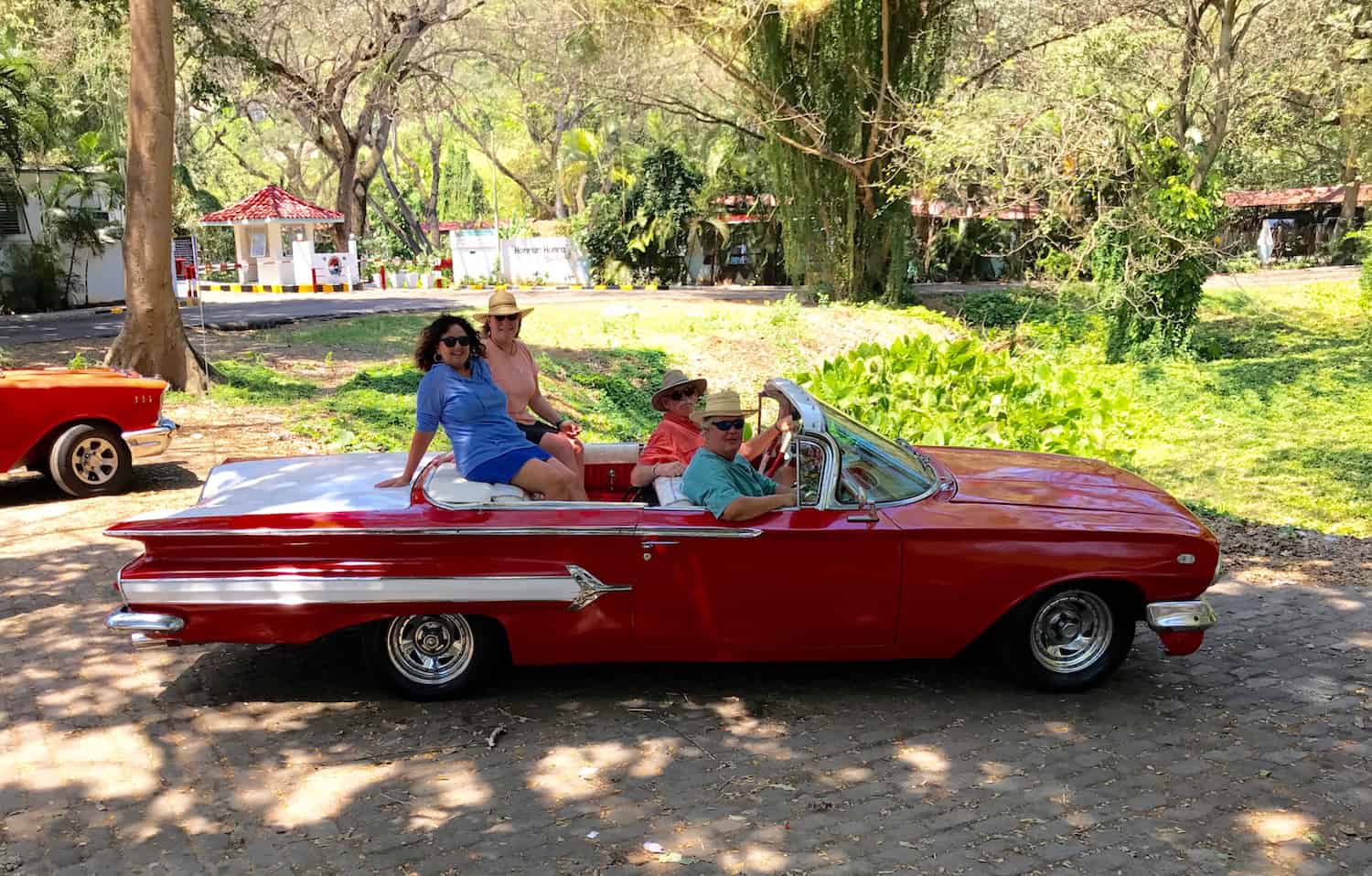
- Phones and internet are available but is still very expensive to locals and very few have access
- The amount of tourists from all over the world is astounding. Americans came late to the party. Tour buses, cruise ships and all inclusive resorts are already par for the course
The city is heaving under the weight of all the tourism and the lack infrastructure is taking a toll. Raul’s reforms since 2010 have brought much-needed economic relief to an impoverished population. Many Cubans are still paid a paltry salary of approximately $20 to $40USD per month for government jobs. Private sector jobs have undeniably improved the lot of many Cubans but have also produced a divide between the private and government workforce in a country that once boasted to have eliminated the class system.
The Cuban people are, much like twenty years ago, colorful, proud, kind and very hopeful for a better future. We are very grateful for the opportunity to have been able to revisit Cuba. After 60 years of isolation this island, which lies so close to our own shores, will be a special cruising ground and a land of discovery for many. Read the article about our previous visit, if you have not done so already.
Travel Tips For Cuba
Tip #1: Exchanging Money In Cuba
Credit & debit cards issued by American banks still don’t work in Cuba, so bring lots of cash. Bring more than you need to be safe. If you run out, you’re out of luck and unless you are a backpacker used to slumming it, it is not cheap in Cuba.
Cuba has two different currencies. The Cuban Convertible Peso (CUC) is the “tourist” currency, pegged to the American dollar at a 1-1 ratio. The Cuban Peso (CUP) is for the locals, and worth a lot less. The official exchange rate from a bank is currently 87CUC to $1.00 U.S. We exchanged with moneychangers (arranged by our taxi driver) and received a better rate at 90CUC.
Tip #2: Transportation In Cuba
Cuban Bus System: Cuba has a government run buscompany for tourists called Viazul that covers most of the country. Tickets aren’t very expensive, but you can’t book them and popular routes sell out fast. Which means you might need to buy your ticket in person at the station the day before.
Renting A Car: We rented a modern car (a small Kea) with a driver for a day trip into the country at $140 USD including a tip, organized for us by our local contact Pedro. Rental cars are not readily available and is not cheap. These cars are REALLY small by American standards and can be sheer torture on a long trip for tall guys like Stephen (6’5”) and Don (6’6”), so understand that before you rent a car.
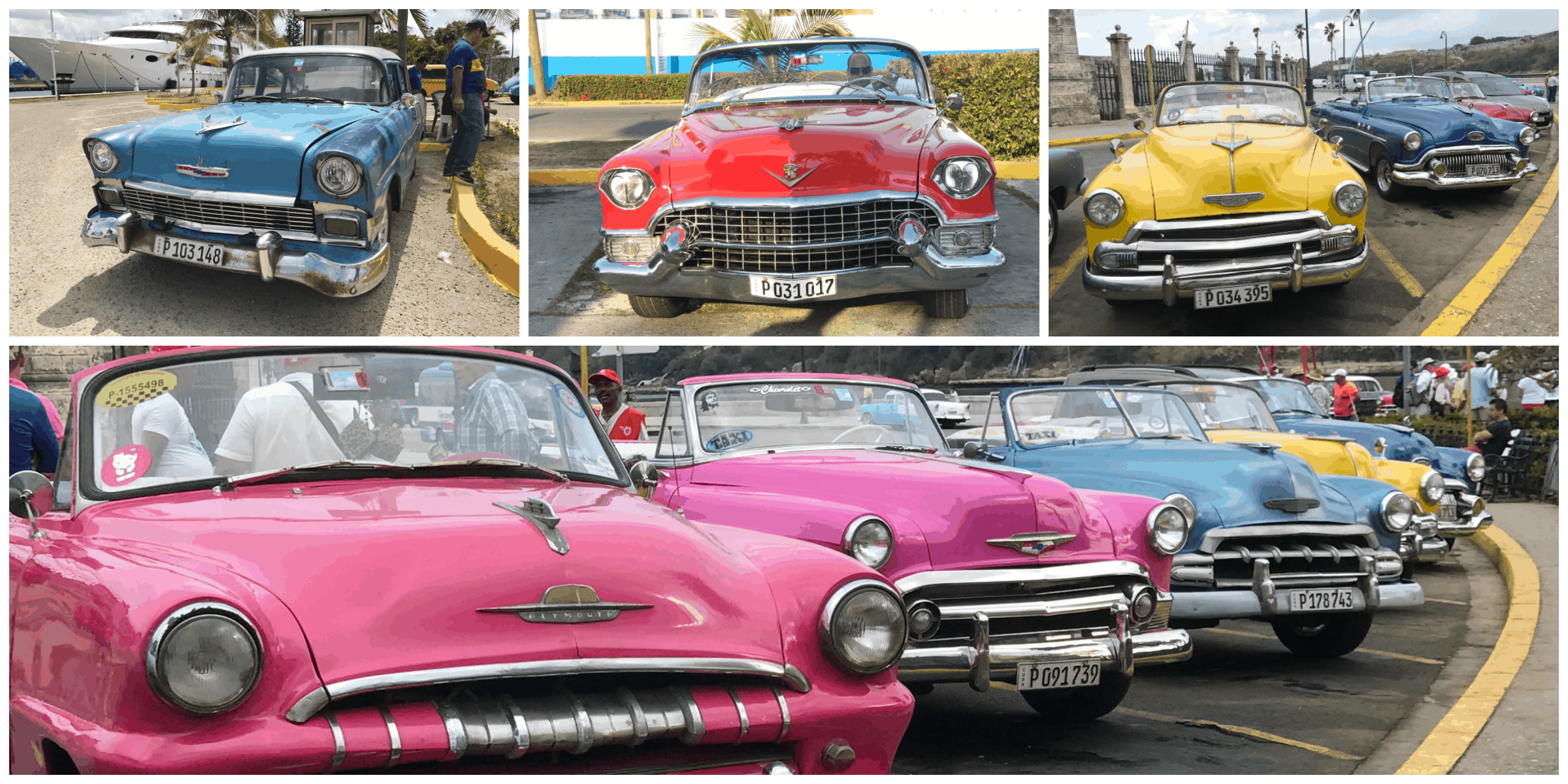
>>Vintage American carsare everywhere: In order to keep them running they have been cannibalized with home made parts. Some have Japanese and Russian engines. Most are loaded with body filler, and painted with rollers using house paint.
Vintage or classic car taxis: The other option for traveling around Cuba is to rent a vintage American car with driver. The cars are super cool but not as dependable, since these cars are literally held together by the owner’s sheer will but it is totally worth it. Depending on your bargaining skills a vintage taxi for a ride in town will cost you $8 – $10. Renting one for a longer 2-3 hour trip can cost around $60 -$70 USD. Again we used our local guy, Pedro and we got a great deal from these guys.
Our Tour Guide / Negotiator: Pedro Luis Martinez Zayas Phone: 5-291-0519 / pedroluisfcb@nauta.cu
Tip #3: Internet In Cuba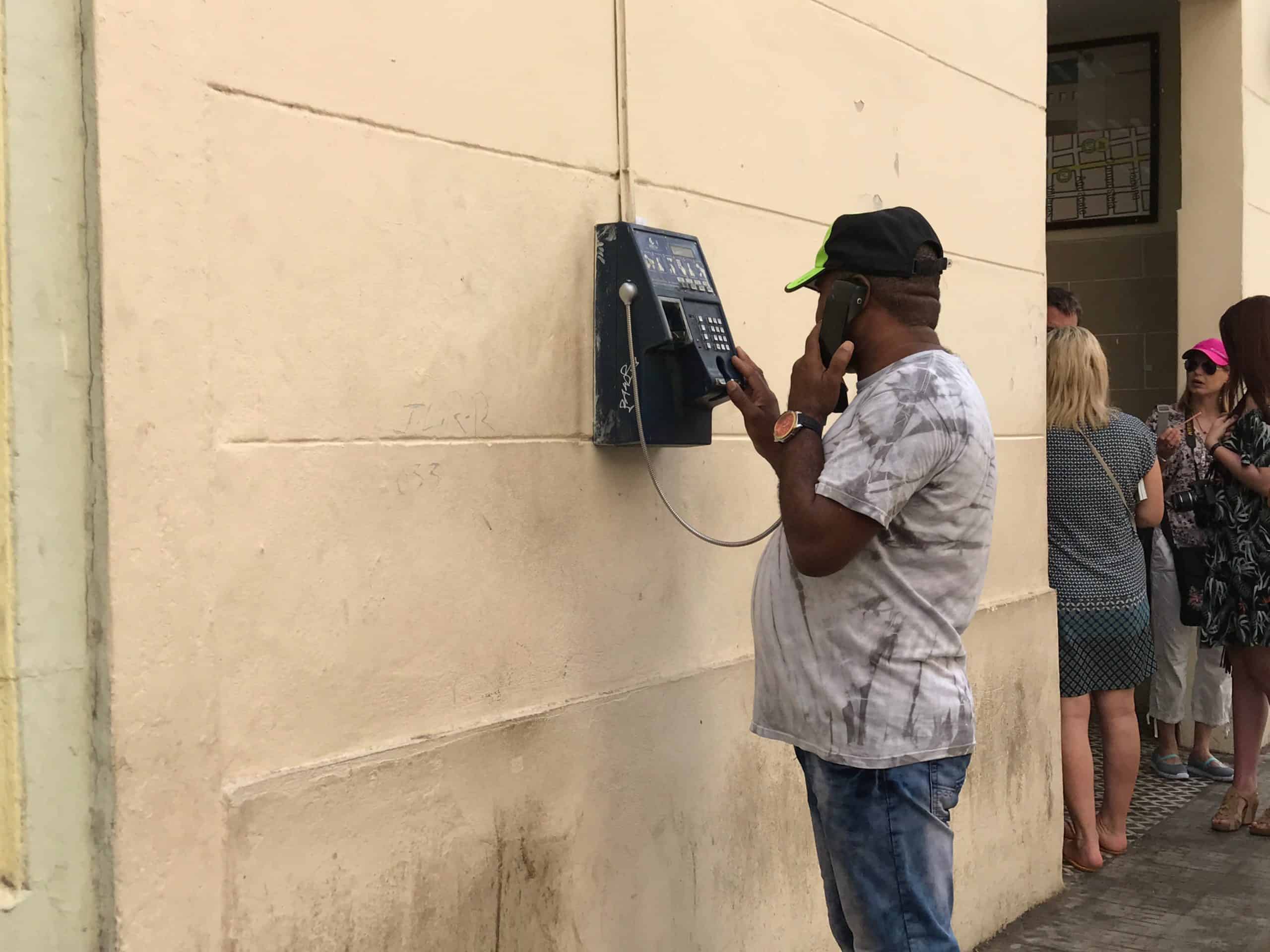
For nearly 60 years Cuba was one of the least connected countries in the world. But despite popular opinion, there is some internet access in Cuba which wasn’t always the case. Locals are definitely able to go online but it is still prohibitively expensive for the Cubans, considering that they earn around $30 – $40 USD in a government job. Internet access is not high on the priority list for them.
The government does censor some materials, like access to Snapchat or anti-government blogs. Tourists can buy ETECSA prepaid Wi-Fi cards at special kiosks for $2 – $3 per hour of service. The scratch-off type cards provide a username and password for ETECSA Wi-Fi networks. The internet isn’t blazing fast, but you can certainly upload web-sized photos to Facebook & Instagram.
>>When last have any of you seen a callbox like this one in Havana?
Tip #4: Cruising Costs In Cuba
 Cuba is not cheap to cruise. At first blush things in Cuba seem to be cheap, considering that produce at the local markets are ridiculously affordable and good. A good meal for two can be under $15 USD in a small “cafe” and the local beer is about $3 or $24/case. A bottle of Havana Club Rum is $6 while a night in a bed and breakfast is around $25/night.
Cuba is not cheap to cruise. At first blush things in Cuba seem to be cheap, considering that produce at the local markets are ridiculously affordable and good. A good meal for two can be under $15 USD in a small “cafe” and the local beer is about $3 or $24/case. A bottle of Havana Club Rum is $6 while a night in a bed and breakfast is around $25/night.
However, things like car rentals at $100+ per day or diesel fuel at $4.00/gal as well as marina costs are at least on a par or more than in the U.S. AND you cannot move from the marina without permission. When you leave the marina, you have to check out and then do the whole process all over again at the next marina. Some of the marina costs are
- Cruising permit for the boat 55CUC ($60 depending on exchange rate)
- Visas per person 75CUC ($81 depending on exchange)
- Marina dockage $0.75/ ft /day for a boat below 45ft
- Marina dockage $1.00/ft/day from 46-74ft boats
- Water $0.06/gallon
- Electricity $0.35/KW
- Fuel $4.00 – $5.00/gallon
- “Tips” for all the officials are around $5.00 / person and there can be as many as 10 during the whole process.
Check out Noonsite’s information about fees for Formalities, Customs, Immigration, Documents etc.
<<Our supply of Havana Club Rum
Tip #5: Speak Spanish?
Many Cubans speak English, particularly the ones who deal with tourists daily. But you will encounter the man on the street who will simply not understand a word.
So, be prepared. Learn a few words of Spanish before you travel to Cuba. Life would be so much easier! I found this Spanish cheat sheet for some basic words and phrases.
Common Spanish Words
- Hello – Hola
- Yes – Sí
- No – No
- Please – Por favor
- Thank you – Gracias
- Excuse me – Perdón
- Good morning – Buenos días
- Good afternoon/good evening – Beunas tardes
- Good night – Buenas noches
- Goodbye – Adios!
Common Spanish Phrases
- Hi, my name is: Hola, me llamo ________
- What is your name?: Como le llama?
- How are you? – Cómo estás?
- I am well, and you? – Bien gracias, y usted?
- Where are you from? – De donde eres?
- I am from: Soy de _________
- I don’t understand – No entiendo
- Where is the restroom? – Donde está el bano?
- How much does this cost? – Cuanto cuesta?




